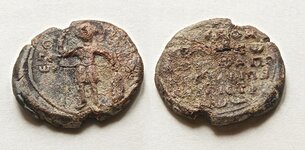PKennett
Jr. Member
I found this lovely 11th century Byzantine lead seal with my older Whites 5900 di/Pro machine in the area of Missis, Turkey. These are not the seals used to mark wax, but rather, these are seals that were used to secure official government (church) documents and packages.

During the Byzantine period, lead bullae (singular, Bulla) were widely used to seal and identify the sender of correspondence and containers in shipment. An iron, pliers-shaped instrument, a boulloterion, was used to impress the designs on a lead bulla seal. After the cord was wrapped around the package or document and the ends inserted in a channel in the blank seal, the seal was placed between the disc shaped engraved dies on the jaws of a boulloterion. The boulloterion had a projection above the jaws, which was struck with a hammer to impress the design on the seal and close the channel around the two ends of the cord. With a bulla in place a container cannot be violated without visible damage to either the bulla or the cord, ensuring the contents remain tamper-proof until they reach their destination.
The hole through this seal can still be seen when you turn iton their edge, and lines up with the indents you see in the photo.
The Byzantine Empire started using these decorated seals around the 9th century - to replace the plain ones used before. It was a way to promote the Empire, it's leaders, and its messages. They are found all over the Byzantine Empire - which stretched from Iraq to Rome. These seals were in use up until the 15th century.
It weighs 17.4g (.62 oz) and is 30mm across, a little larger than a U.S. quarter.
It made a huge racket when I swept over it!
Thanks to a helpful guy at http://www.forumancientcoins.com I now have a full ID of this seal. It belongs to a person named Apnelgaripes, who held the high rank of 'magistros' or Governor of Cilicia (south central Turkey today). He was born in Vaspurakan, Armenia, and was an Orthodox Christian. He controlled the Ancient cities of Missis, Adana, and Lampron castle near Tarsus.
The obv. shows a standing saint George.
The reverse has the following greek inscription:
KЄ ROH
ΘЄI Tω Cω
ΔOVΛω AП
NЄΓPIΠH
MΓITPω
It translates to "Lord aid your servant Apnelgaripes magistros"
The seal can be dated to the last third of the 11th century.
Note that Sigillography (sometimes referred to under its Greek name of Sphragistics) is one of the auxiliary sciences of history. It refers to the study of seals attached to documents as a source of historical information. It concentrates on the legal and social meaning of seals, as well as the evolution of their design. It has links to diplomatics, heraldry, social history, and the history of art.

During the Byzantine period, lead bullae (singular, Bulla) were widely used to seal and identify the sender of correspondence and containers in shipment. An iron, pliers-shaped instrument, a boulloterion, was used to impress the designs on a lead bulla seal. After the cord was wrapped around the package or document and the ends inserted in a channel in the blank seal, the seal was placed between the disc shaped engraved dies on the jaws of a boulloterion. The boulloterion had a projection above the jaws, which was struck with a hammer to impress the design on the seal and close the channel around the two ends of the cord. With a bulla in place a container cannot be violated without visible damage to either the bulla or the cord, ensuring the contents remain tamper-proof until they reach their destination.
The hole through this seal can still be seen when you turn iton their edge, and lines up with the indents you see in the photo.
The Byzantine Empire started using these decorated seals around the 9th century - to replace the plain ones used before. It was a way to promote the Empire, it's leaders, and its messages. They are found all over the Byzantine Empire - which stretched from Iraq to Rome. These seals were in use up until the 15th century.
It weighs 17.4g (.62 oz) and is 30mm across, a little larger than a U.S. quarter.
It made a huge racket when I swept over it!
Thanks to a helpful guy at http://www.forumancientcoins.com I now have a full ID of this seal. It belongs to a person named Apnelgaripes, who held the high rank of 'magistros' or Governor of Cilicia (south central Turkey today). He was born in Vaspurakan, Armenia, and was an Orthodox Christian. He controlled the Ancient cities of Missis, Adana, and Lampron castle near Tarsus.
The obv. shows a standing saint George.
The reverse has the following greek inscription:
KЄ ROH
ΘЄI Tω Cω
ΔOVΛω AП
NЄΓPIΠH
MΓITPω
It translates to "Lord aid your servant Apnelgaripes magistros"
The seal can be dated to the last third of the 11th century.
Note that Sigillography (sometimes referred to under its Greek name of Sphragistics) is one of the auxiliary sciences of history. It refers to the study of seals attached to documents as a source of historical information. It concentrates on the legal and social meaning of seals, as well as the evolution of their design. It has links to diplomatics, heraldry, social history, and the history of art.
Amazon Forum Fav 👍
Upvote
1





